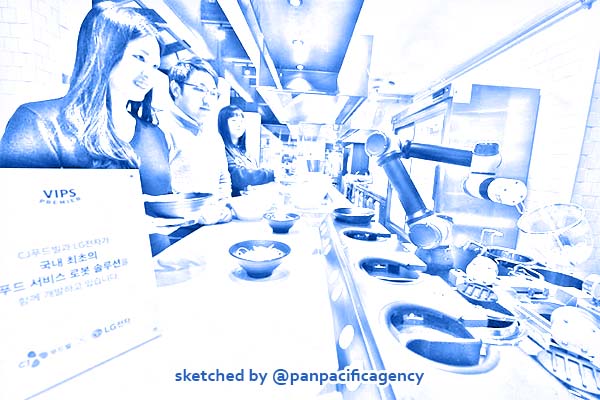Robots replace humans at Korean restaurants

Customers wait for LG Electronics' CLOi Chefbot to cook noodles at a VIPS restaurant in western Seoul, Nov. 22. / Courtesy of LG Electronics. Sketched by the Pan Pacific Agency.
SEOUL, Nov 25, 2019, The Korea Times. The food and beverage industry here has seen an increasing use of robots to serve food and beverages and even complete basic tasks such as making noodles in less than a minute, The Korea Times reported.
Industry officials said Sunday that more robots will be used in restaurants with the development of robotic technologies and soaring demand to utilize robots for routine and repetitive tasks, replacing human employees.
LG Electronics said it has deployed a robot chef called the CLOi Chefbot to a Seoul branch of VIPS restaurant in cooperation with the family restaurant chain operator CJ Foodville.
At the restaurant, which allows customers to assemble all-you-can-eat noodles, the CLOi Chefbot cook various kinds of noodles in less than a minute after visitors put the ingredients they want to eat in a bowl and hand it in to the robot chef.
LG has been cooperating with CJ Foodville, a subsidiary of food and entertainment conglomerate CJ Group, to develop serving and chef robots for restaurants since April.
The two companies decided to deploy the robot chef for the noodle-making process to spare employees from having to face hazardous, physically demanding and repetitive tasks such as dealing with boiling water and hot ingredients.
“This is the first time that LG launched a robot chef to restaurant. CJ Foodville helped us a lot in developing the CLOi Chefbot as they gave advice on where the robot chefs can be used the most efficiently,” an LG official said.
“We expect the chef robot will reduce repetitive and dangerous tasks and will subsequently enable restaurants to focus on better serving their customers.”
Taking this as a stepping stone, Roh Jin-seo, head of LG’s robotics business, said the two companies plan to increase the use of chef robots.
“Thanks to the cooperation with CJ Foodville, LG could offer a differentiated value to customers. We will try to find more ways to utilize robotics in the food and beverage sector to provide enhanced customer experience and improve its competitiveness in the robot business,” Roh said.
LG isn’t the only company actively trying to develop more advanced robots to be put to work in the food and beverage industry.
Mobile carrier KT has been operating robot baristas at local coffee franchise Dal.komm Coffee’s stores in Seoul since December 2018.
Powered by KT’s fifth-generation (5G) network and artificial intelligence (AI) technologies, the robot takes coffee orders remotely through a mobile app or kiosk cashier and makes fresh brewed coffee using an espresso machine.
Samsung Electronics also developed a cooking assistant robot called Samsung Bot Chef which it displayed at the Kitchen & Bath Industry Show (KBIS) in Las Vegas, January.
The robot is designed to help not only general users but also disabled people as it can cut or chop ingredients and mix sauces using its robotic arm.
An industry official said there will be an increasing demand for adopting robotics in the restaurant business because companies can proactively address labor cost issues and replace much of the manual labor by human employees.
“Bringing in robotics to the kitchen is expected to rise as companies can reduce a large amount of manual labor of their employees and proactively respond to rising labor costs. Also, by letting robots do hazardous and routine jobs, companies can efficiently use their resources and focus more on improving customer service,” the official said.
By Baek Byung-yeul